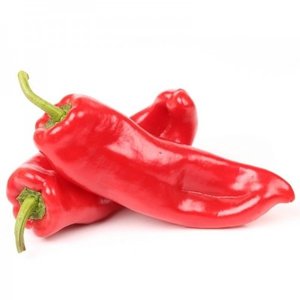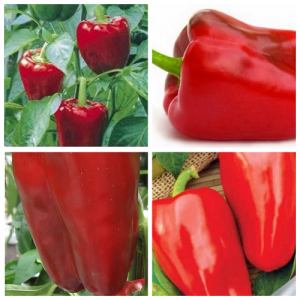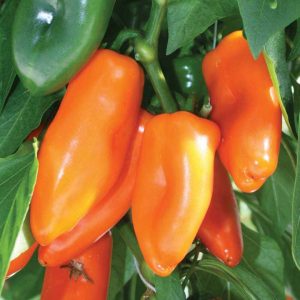A variety that can become your favorite - the "Volovye ear" pepper and the secrets of its cultivation
The cow's ear pepper is popular due to its high yield and large fruits. The taste of vegetables is sweet and rich, and the flesh is thick and juicy. The variety is often found in markets and supermarkets: due to its high productivity, it is grown not only for itself, but also for sale.
At the same time, the Cow's ear is a culture that is quite demanding for care. She does not tolerate frost and too high temperatures. However, knowing the basic rules of agricultural technology, it is easy to cope with the cultivation of pepper.
The content of the article
Description of the variety

Cow's ear is a pepper bred by domestic breeders. Although it appeared on the markets relatively recently, it has already won the recognition of gardeners.
Various companies produce seeds of culture: "Siberian Garden", "Aelita", "Seeds of Altai".
The cow's ear is a cultivar, not a hybrid, so grains from its fruits are also suitable for planting. They are collected from the largest and most beautiful peppers, fully ripe on the bush.
Features:
The main feature of the Bovine Ear is its fruits. They are large and have an unusual shape, which really resembles the ear of an artiodactyl.
The flesh of vegetables is thick, making them versatile in cooking. The fruits are suitable for fresh consumption, pickling, cooking hot dishes, lecho.
Advice! Delicious lecho is obtained from thick-walled fruits, so the cow's ear is great.
The fruits are bright red with a sweet taste and pronounced peppery aroma. The taste does not change even in unripe vegetables. Many gardeners collect red-green peppers from the bush.
Plant immunity is high. The variety is rare sick - it does not have to be treated with chemicals for prevention purposes.
Negative features of the Bovine ear - susceptibility to high and low temperatures and not always full germination of seeds.
Main characteristics
The cow's ear is appreciated for the taste of the fruit and high yield. It is often grown for sale.
The main parameters of the variety are presented in the table:
| Parameter | Indicators |
| Bush type | Low. Height - 50–85 cm. Bushes are strong, with a thick stem and shoots. The crown is spreading. The leaves are small, but there are many. The leaf plate is light green, common to peppers. The inflorescences are simple. |
| Growing method | In the southern regions, they are grown outdoors (in hot greenhouse peppers begin to shed inflorescences). In the central and northern regions, they are planted in a greenhouse or under film shelters. |
| Yield | High: from 1 bush to 3.5 kg of yield. |
| Fruit | Large. The weight of each is from 150 to 250 g. The color is bright red, the skin is glossy. There are fruits with green spots. The shape is elongated, with a pointed tip, flattened on both sides. The length of the peppers reaches 15 cm. There is no pronounced ribbing. The pulp is thick (up to 8 mm) juicy. The taste is rich sweet with a peppery aroma. Even green fruits lack bitterness. |
| Transportability | High. Dense vegetables do not wrinkle when transported over long distances. Stored for up to a month. |
| Ripening terms | Mid-season variety. The fruits ripen by early September (120–130 days from the first shoots). |
| Disease resistance | Resistant to most nightshade diseases. |
Preparation for growing
Peppers are grown in seedlings. Sowing begins in early March.
Before this, the seeds are prepared for their better germination and increasing the resistance of plants to adverse environmental factors:
- Planting material is sorted out... First, darkened and damaged specimens are removed from the total mass. The remaining grains are soaked in warm water, the floating ones are removed.
- For half an hour, the seeds are soaked in a light pink solution of potassium permanganate. The dressing prevents contamination of the plants.
- The material is wrapped in lukewarm water (or growth stimulant solution) pieces of gauze. They are placed in a deep container, which is placed in a warm place for 2-3 days to swell the seeds. Periodically add liquid to the container.
For seedlings, use a light but nutritious soil. It is bought in a store or prepared on its own by mixing peat and garden soil in equal proportions. On a bucket of this composition, take 2 kg of sand and 1 tbsp. ash.
The soil is watered with a dark pink solution of potassium permanganate and hot copper sulfate, poured into a sowing container and left in a warm place to warm up the earth.
Pepper belongs to crops that do not tolerate picking well. Therefore, gardeners immediately use individual containers for sowing. The volume of the pots should be 150-200 ml. It is better to choose a peat container: you do not have to extract plants from it, even when diving to a permanent place.
When planting a large number of peppers, you can also use a common box (with drainage holes at the bottom).
The containers are disinfected: poured with boiling water or soaked for half an hour in a solution of potassium permanganate.
Growing seedlings
When the soil in the boxes warms up, they start sowing. This is done 80 days before the expected planting of the pepper in a permanent place.
Seedlings are grown both in the greenhouse and at home. In the first case, the plants are stronger and more viable. It is easy to provide suitable temperature and lighting in a special room. It is convenient to plant seeds immediately in a heated greenhouse, and because the plants are sown on a common garden bed and do not dive until 80 days have passed. During this time, the bushes are thinned out several times.
When growing on a windowsill, you should be more attentive to the lighting of the seedlings and avoid drafts.
Planting pepper
When sowing in a common box, depressions of 2.5 cm are made in the soil. The distance between the rows is 3-4 cm. The seeds are laid out in holes with an interval of 3 cm. Sprinkle with soil on top and watered with warm water with the addition of a growth stimulator. The boxes are covered with foil and placed in a warm, dark place until the first shoots appear.
In individual pots, 2 seeds are planted in each container to a depth of 3 cm. The container is covered with a foil and put into heat until the seeds germinate. After the appearance of 2 true leaves, the weaker stem is pinched.
Important! If the seedlings are grown in individual pots, then a layer of disinfected drainage (coarse sand, broken dishes, fine gravel, crushed expanded clay or bricks) is poured onto the bottom of each.
Further care
Pepper is a whimsical culture, but knowing a few secrets of agricultural technology, it will be easier to grow it:
- After the first shoots, the film is removed. The seedlings are rearranged on the windowsill. It is important to protect the plants from drafts.

- To ensure that the peppers receive light evenly, the pots are constantly turned towards the window.... If there are signs of a lack of lighting (the plants have become lethargic, began to stretch and turn yellow), provide additional illumination with fluorescent lamps.
- When real leaves appear, they are dived (if the seeds were planted in a common box). To do this, carefully, holding the pepper by the leaves and helping with a fork, it is removed from the container and transplanted into pots filled with drainage and soil. The root collar is not buried. The soil is abundantly moistened immediately after the pick. The next watering is carried out no earlier than 10 days later.
- Water the pepper as the topsoil dries. Warm water is poured under the root.
- 10 days before planting the culture in the ground, it is hardened: taken out into the street or balcony every day during warm hours. Start from 1 hour, gradually increasing the duration to 8-10 hours.
The cow's ear is sensitive to feeding. The soil in which the seedlings are grown must be fertilized. Do this 3 times:
- The first time feeding is applied after the appearance of 2 true leaves. Mineral fertilizers are suitable for this: 10 g of ammonium nitrate, 15 g of superphosphate and 5 g of potassium salt are added to 5 liters of water.
- Fertilizers are applied again 2 weeks after the previous feeding. For 5 liters of water, take 20 g of ammonium nitrate, 30 g of superphosphate and 10 g of potassium salt.
- The last time the seedlings are fed 5 days before the pick to a permanent place... Add 1 tbsp to 5 liters of water. ash and 25 g of superphosphate.
Picking to a permanent place
Well-lit and windless areas of the garden are chosen for the Ox's ear. Liquid should not stagnate in them.
The best predecessors of a vegetable are melons, legumes, cereals and cabbage. Do not plant a culture after nightshades. Different varieties of peppers are easily pollinated. Therefore, they are either planted at different ends of the garden, or tall plants are placed between the beds: for example, corn.
The beds are prepared in autumn - they are dug up and cleaned of weeds. The soil is mixed with humus, ash and superphosphate. A week before planting, the soil is leveled with a rake and cleaned of weeds, watered with copper sulfate.
Planting scheme of the variety - 50X40. So on 1 m2 4-5 plants are placed. The pepper is planted in the holes along with a lump of earth. The root collar of plants is not buried.
Features of growing varieties
The bushes of the Ox's ear are not high - it is not necessary to tie them up. If, under the weight of the fruit, the bushes still begin to lean to the ground, then you will have to attach them to the support.
The formation of a bush is not required: the abundance of fruits provides precisely the spreading of the variety.
The leaves at the bottom of the bush are removed. They get rid of yellowed and withered greens.
A cow's ear is demanding on the composition of the soil. The vegetable is fed at least 3 times per season. Complex mineral and organic fertilizers are used.
The variety is sensitive to temperature changes. In the greenhouse, the room is ventilated and monitored so that the temperature is not too high. On hot days, put a fan. On the street, during cold snaps, the pepper is covered with a film, otherwise it will simply die due to frost.
Care Tips
Experienced gardeners know the secrets of a rich pepper harvest:
- The beds are mulched with rotted hay to protect the roots of the culture from freezing, pests and diseases.
- Water the pepper at least 2 times a week only at the root. Before flowering, the bushes are sprayed with warm water.
- To attract pollinating insects during flowering, the beds are sprayed with sweet water (1 cup sugar per bucket of water). Add 1 tbsp to the mixture. l. boric acid for quick formation of ovaries.
Separately, it is worth talking about dressings, the recipes for which there are enough:
- In 6 liters of water for 3 days, the crushed peel of 4 bananas and the shell of 6 eggs are insisted. The mixture is used for the first feeding. For each plant, 1 liter of fertilizer is taken.
- Add 8 tbsp to 4 liters of hot water. l. ash, insist day. Water the peppers while setting the fruit.
- Chopped chamomile, plantain, nettle are poured into the bucket. The total mass of greens should take up half the container. The rest of the volume is filled with ice water. Insist on this "tea" for a week. After diluted with water in a ratio of 1:10. Water it every 7-10 days, 3-4 liters per 1 m2.
- For every 5 liters of water, take 0.5 kg of chicken manure, insist 5 days. 1 liter of fertilizer is poured under each bush during the flowering period.
Typical diseases and pests
The cow's ear is resistant to most diseases characteristic of pepper. To minimize the risks of infection of plants, once a week they are sprayed with a solution of "Fitosporin".
Pepper is not protected from insects. There are several folk remedies for pest control:
- From aphids, spider mites and other small insects, the bushes are sprayed with a soap and onion solution. To prepare it, add 1 piece of grated laundry soap, 1 onion chopped in a meat grinder and 2 small hot peppers to a bucket of water. The remedy is insisted for a day. It is also used for prevention.
- To scare off slugs, sprinkle the leaves of vegetables with tobacco or ash.
- To protect the roots from the bear, crushed eggshells are poured into the holes.
Advantages and disadvantages of the variety
Advantages of the Bovine Ear:
- high productivity;
- strong immunity to disease;
- no garter or pinning required;
- meatiness and great taste of the fruit;
- large sizes of vegetables.
Pepper also has disadvantages:
- sensitivity to temperature changes;
- exactingness to the composition of the soil;
- poor tolerance of picks.
Reviews
Despite the fact that the variety is picky about care, it pleases with high yields and excellent fruit taste. Gardeners speak generally positively about the variety.
Victoria, Voronezh: “I have been growing a cow's ear for several years. This variety ousted all other peppers from my garden. Its fruits are huge and bright, like in the photo. The walls are thick and fleshy, the taste is sweet. It makes the most delicious lecho. Of course, you will have to tinker with the cultivation. To prevent the plants from dying, it is important to regularly feed. You won't be able to grow it at the dacha you go to on weekends. "
Igor, Ryazan: “The first time I tried to grow Volovye Heart 3 years ago. I planted it in open ground early, and all the plants died. For a long time he did not dare to try this variety again, but the desire to have fruits in the garden, as in the market, won. It worked out last year. True, I grew it under a film. It is imperative to mulch the soil, preferably with humus. I fed the plants only with silage with the addition of superphosphate. "
Read also:
How to salt bell peppers for the winter whole quickly and tasty.
Conclusion
A cow's ear requires regular care. The variety does not tolerate heat and cold and is ill with a lack of fertilizers. By following the basic rules of agricultural technology and daily inspecting the bushes for negative changes, you will get a rich and tasty harvest.